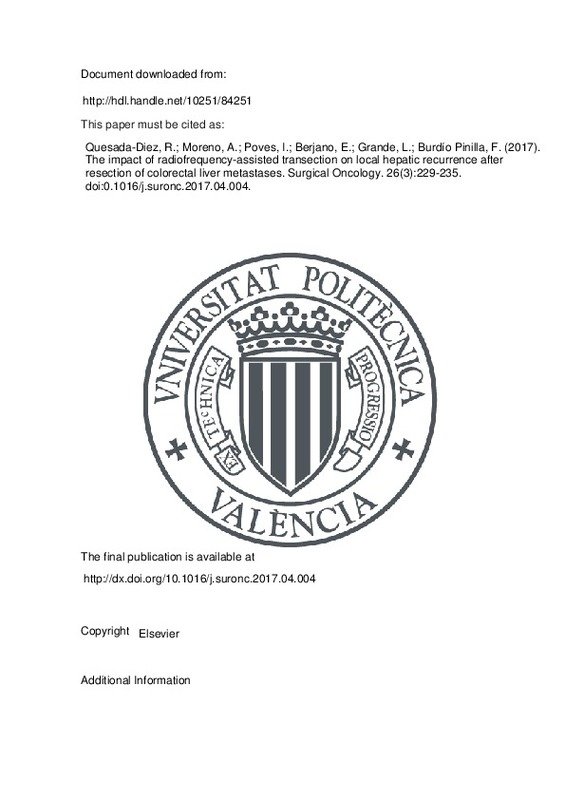JavaScript is disabled for your browser. Some features of this site may not work without it.
Buscar en RiuNet
Listar
Mi cuenta
Estadísticas
Ayuda RiuNet
Admin. UPV
The impact of radiofrequency-assisted transection on local hepatic recurrence after resection of colorectal liver metastases
Mostrar el registro sencillo del ítem
Ficheros en el ítem
| dc.contributor.author | Quesada-Diez, Rita
|
es_ES |
| dc.contributor.author | Moreno, A.
|
es_ES |
| dc.contributor.author | Poves, Ignasi
|
es_ES |
| dc.contributor.author | Berjano, Enrique
|
es_ES |
| dc.contributor.author | Grande, Luis
|
es_ES |
| dc.contributor.author | Burdío Pinilla, Fernando
|
es_ES |
| dc.date.accessioned | 2017-06-30T11:45:34Z | |
| dc.date.available | 2017-06-30T11:45:34Z | |
| dc.date.issued | 2017 | |
| dc.identifier.issn | 0960-7404 | |
| dc.identifier.uri | http://hdl.handle.net/10251/84251 | |
| dc.description.abstract | Resection is the gold standard in the treatment of liver metastases from colorectal cancer. An internal cooled radiofrequency electrode was described to achieve tissue coagulation to a greater margin width. The aim of this study is to determinate if a RFassisted transection device (RFAT) has any effect on local hepatic recurrence (LHER) compared to conventional technologies. A study population of 103 patients who had undergone a hepatic surgical resection was retrospectively analysed. Patients were classified into two groups according to the device used: a RF-assisted device (RFAT group; n=45) and standard conventional devices (control group; n=58). LHER was defined as any growing or enhancing tumour in the margin of hepatic resection during follow-up. Cox proportional models were constructed and variables were eliminated only if p>0.20 to protect against residual confounding. To assess the stability of Cox’s regression model and its internal validity, a bootstrap investigation was also performed. Baseline and operative characteristics were similar in both groups. With a mean followup of 28.5 months (range 2-106), in patients with positive margins, we demonstrated 0% of LHER in RFAT vs. 27% in control group (p=0.032). In the multivariate analysis five factors demonstrated significant influence on the final model of LHER: RFAT group, size of the largest metastases, number of resected metastases, positive margin and usage of Pringle-manoeuvre. This study suggests that parenchymal transection using a RFAT able to create deep thermal lesions may reduce LHER especially in case of margin invasion during transection | es_ES |
| dc.language | Inglés | es_ES |
| dc.publisher | Elsevier | es_ES |
| dc.relation.ispartof | Surgical Oncology | es_ES |
| dc.rights | Reserva de todos los derechos | es_ES |
| dc.subject | Local hepatic recurrence | es_ES |
| dc.subject | Liver resection | es_ES |
| dc.subject | Radiofrequency | es_ES |
| dc.subject | Ccolorectal cancer | es_ES |
| dc.subject.classification | TECNOLOGIA ELECTRONICA | es_ES |
| dc.title | The impact of radiofrequency-assisted transection on local hepatic recurrence after resection of colorectal liver metastases | es_ES |
| dc.type | Artículo | es_ES |
| dc.identifier.doi | 10.1016/j.suronc.2017.04.004 | |
| dc.rights.accessRights | Abierto | es_ES |
| dc.contributor.affiliation | Universitat Politècnica de València. Escuela Técnica Superior de Ingeniería del Diseño - Escola Tècnica Superior d'Enginyeria del Disseny | es_ES |
| dc.description.bibliographicCitation | Quesada-Diez, R.; Moreno, A.; Poves, I.; Berjano, E.; Grande, L.; Burdío Pinilla, F. (2017). The impact of radiofrequency-assisted transection on local hepatic recurrence after resection of colorectal liver metastases. Surgical Oncology. 26(3):229-235. doi:10.1016/j.suronc.2017.04.004 | es_ES |
| dc.description.accrualMethod | S | es_ES |
| dc.relation.publisherversion | http://dx.doi.org/10.1016/j.suronc.2017.04.004 | es_ES |
| dc.description.upvformatpinicio | 229 | es_ES |
| dc.description.upvformatpfin | 235 | es_ES |
| dc.type.version | info:eu-repo/semantics/publishedVersion | es_ES |
| dc.description.volume | 26 | es_ES |
| dc.description.issue | 3 | es_ES |
| dc.relation.senia | 336015 | es_ES |







![[Cerrado]](/themes/UPV/images/candado.png)

